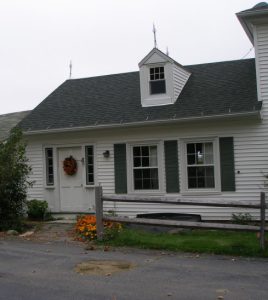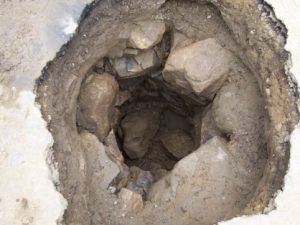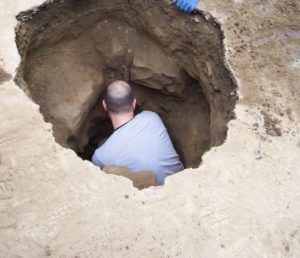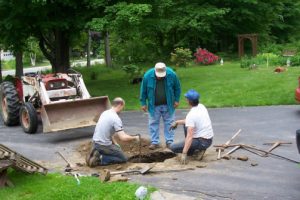
Researching family history takes us to many places: libraries, museums, various genealogical repositories (New England Historic Genealogical Society, of course!), cemeteries, and . . . driveways. An historical archaeological adventure is the sort of research that happened when I wasn’t looking!
The dooryard and then the driveway of my old Asa Williams house had always been hard-packed dirt, until in 1979 my father had the chance to have it paved, making it easier to plow in winter and eliminating the usual signs of mud season. If asphalt improved the look of things, it also covered a multitude of landscaping sins. I don’t remember any difficulties with the driveway in the years that I lived here before college, but when I returned as the owner of My Old House things changed.
The paving was still hard and intact when our moving truck arrived and unloaded the day we returned. It presented no difficulties with plowing during the winter. But by spring, a somewhat circular spot appeared, right smack in the middle of the driveway in front of the kitchen windows and head on to the garage door. The earth moved for us then, and all of it downward, sinking an inch or more at a time, rising as the frost heaved it, then sinking again even more.
Out with the shovels and pickaxes, up with the asphalt pieces broken out and scattered around the driveway, and there it was: an old dug well.
That would be THE old well. The well Asa most likely dug right outside the kitchen door for quick access from the house and forge. The well dug into the underlying stream, approximately 15’ deep, lined with boulders in a stacked, circular manner, and filling quite nicely with water.

 We filled it with gravel; it sank and filled with water. We filled it with sand and gravel; it sank and filled with water. We filled it with sand, gravel, and rocks; it sank and filled with water. Obviously, more drastic methods were required, so we dug everything out. Then we brought in the chains and tractor to pull out the original boulders and bigger rocks. And we dug down. After both my husband and son-in-law disappeared into the well hole, shovels and all, as an historic archaeologist looked on accompanied by my daughter, my brother, and two dogs, we thought we had finally dug out enough to refill it with 2” of crushed stone, followed by 80 pounds of quick-setting concrete mix and 2 yards of gravel on top. A thorough soaking set everything. It sinks no more.
We filled it with gravel; it sank and filled with water. We filled it with sand and gravel; it sank and filled with water. We filled it with sand, gravel, and rocks; it sank and filled with water. Obviously, more drastic methods were required, so we dug everything out. Then we brought in the chains and tractor to pull out the original boulders and bigger rocks. And we dug down. After both my husband and son-in-law disappeared into the well hole, shovels and all, as an historic archaeologist looked on accompanied by my daughter, my brother, and two dogs, we thought we had finally dug out enough to refill it with 2” of crushed stone, followed by 80 pounds of quick-setting concrete mix and 2 yards of gravel on top. A thorough soaking set everything. It sinks no more.
 As the historic archaeologist waved goodbye just before we could hand him a shovel, he reminded us to call him if we found anything. We didn’t need to. The only things that came out of that 227+year-old well hole were sand, gravel, water, rocks – and eventually my husband and son-in-law. Not a single valuable archaeological artifact to make us all wealthy. Such is the hallmark of my family research.
As the historic archaeologist waved goodbye just before we could hand him a shovel, he reminded us to call him if we found anything. We didn’t need to. The only things that came out of that 227+year-old well hole were sand, gravel, water, rocks – and eventually my husband and son-in-law. Not a single valuable archaeological artifact to make us all wealthy. Such is the hallmark of my family research.
Now, if you ask me about skeletons or old shoes, black books or Bible stories, horses or herbs, I’ll have a different story to tell!
As a safety engineer with 16 years experience, you were very lucky that parts of the well did not collapse on you. Please think about safety before you or others start such projects.
Howland, that’s an excellent point that deserves emphasis. What I did not describe in my story is that, in addition to an historical archaeologist, we also had in attendance a physicist, an engineer, a former paramedic, an expert in light industrial equipment, and a lawyer. We did not start this lightly, and had the bases covered (we made the lawyer go down first).
Kudos to you for inviting an historical archaeologist to monitor the proceedings. As you already know, wells are often the richest source of artifacts and clues to daily life that are rarely documented in the written records. As an archaeologist, I do admit that I, like Howland above, did feel uncomfortable about the increasing depth of the narrow hole, another reason to have a professional like the historical archaeologist on hand; so glad there were no unintended consequences.
“Richest source of artifacts”… except the privy. Did you find that yet?
I’m not sure I’d want to crawl in there.
We do know where the outhouses were: right under our current garage. When that 1950s structure is replaced, we’ll have the opportunity to dig to unearth what’s left of the privy area as well as the old forge and carriage houses. Rest assured, I’m done crawling into anything like that!
I’ve enjoyed all your posts about your old house, because I love old houses and the possible stories they may tell (especially if they were owned by a family member), and because I grew up in Augusta from 1949-1964, and it’s nice to think about its history.
Thanks for your sharing!
I’m a historical archaeologist. My next article for American Ancestors magazine is going to be on how archaeology can provide information on family histories.
Our Eureka, CA, home is only 125 years old, a Victorian because it was built on the back of a gulch. In a remodel in 1987, 100 years after it was built, I discovered an old outhouse under a porch. Poking out a car axle, deeper I found a high button show, a washing machine ringer, and an auto hood-the only thing salvageable was the brass hinges.